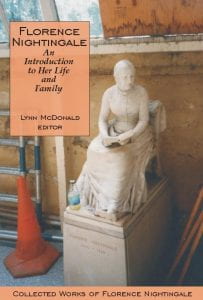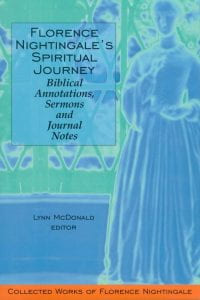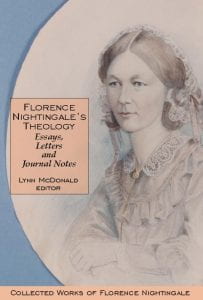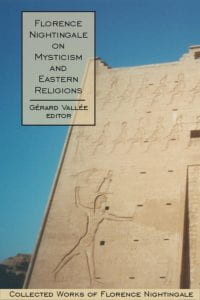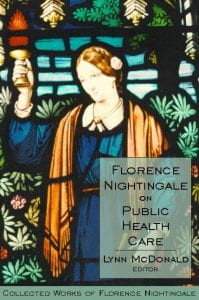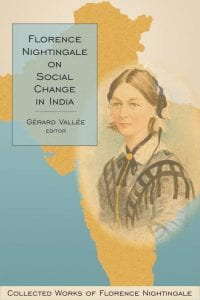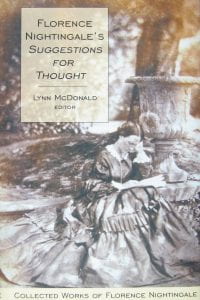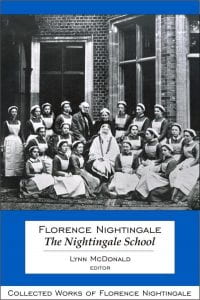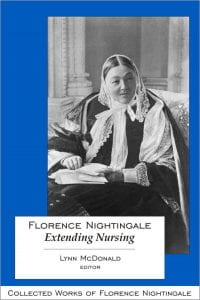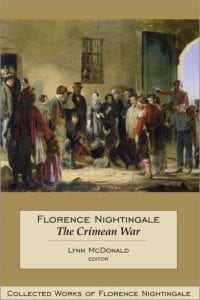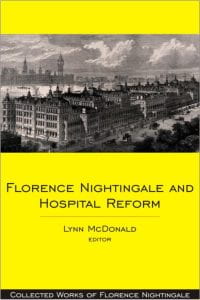The Collected Works of Florence Nightingale:
Volume 1, Life and Family, begins with an introduction to Nightingale’s life and family relationships. It reports a substantial number of letters to her mother, father and sister and then to her large extended family. This material shows quite a different Nightingale from the usual portrayal, and much more nuance in the frustrating relationship she had with her sister. The third part of the volume reports her domestic arrangements, from recipes, cat care and relations with domestic employees to her caseload of “waifs and strays” and charitable donations. There is much new material here as there is in every volume.
Volume 2, Spiritual Journey, begins with an introduction to Florence Nightingale’s religious beliefs and their sources. The second and largest part of the volume consists of her biblical annotations, made in six languages in addition to English and never before published. There are three sermons she wrote (not given in her lifetime), and her journal notes, including a diary for 1877, again not published before. This material is highly personal and some is profoundly moving, notably her reflections on her “jubilee,” or the fiftieth year after her “call to service” at age sixteen.
The volume shows Nightingale’s struggles with her own church—she was a life-long member of the Church of England, despite her objections to much of its theology, its social conservatism and lack of a role for women. Wesleyan and Lutheran influences are evident in her strong faith, which was nurtured by wide reading, from the medieval mystics, Puritans, many Catholic authors, the German historical school and liberal Protestants.
Volume 3, Theology, presents Nightingale’s unconventional theological views with her essays (all but two previously unpublished), letters, journal notes, three “visions,” proposals for an edition of the Bible for children, and excerpts from her devotional reading. There is correspondence with such Roman Catholic notables as Cardinal Manning and the “dearest reverend mother” of the Convent of Mercy, with Protestants from the liberal Benjamin Jowett, her unorthodox father, evangelical brother-in-law and various clergy and missionaries. Theology shows the great diversity of sources that nourished Nightingale’s faith, and how that faith grounded all her practical work in nursing and social reform.
Volume 4, Mysticism and Eastern Religions, edited by Gérard Vallée, professor emeritus at McMaster University, is the third volume in the Collected Works on Nightingale’s religion. It begins with the publication for the first time of her Notes on Devotional Authors of the Middle Ages, translations from and comments on the medieval (and some later) mystics that nourished her own life of faith. Her annotations of and comments on the Imitation of Christ follow. The largest part of the volume consists of her Letters from Egypt (complete publication for the first time) and includes (also for the first time) correspondence on her preparation for the trip to Egypt and reflections on it over the years later. As well there is correspondence and journal notes on Eastern religions, mainly Hinduism.
Volume 5, Society and Politics, presents the main elements of Nightingale’s work as a social reformer and political activist. It begins with the clarification of her own methodological position, drawing on the “social physics” of the Belgian statistician, Quetelet. It reports her pioneering questionnaires and analyses of social data. It covers her (failed) attempts to reform the Census.
This volume shows the broad range of Nightingale’s reform agenda, including income security and home ownership for the poor. Her views of the political process, imperialism and votes for women are given, down to specifics of her promotion of particular (Liberal) political candidates. There is correspondence with such political notables as Queen Victoria, W.E. Gladstone, John Stuart Mill and General Gordon. The last section reports her views on education and her intellectual interests, notably her comments on the Dialogues of Plato, other philosophers, natural scientists, novelists and poets.
Volume 6, Public Health Care, includes a critical edition of Nightingale’s Notes on Nursing for the Labouring Classes, papers on mortality rates in aboriginal schools and hospitals and her work on rural health. Public Health Care reports Nightingale’s signal contribution of bringing professional nursing into the dreaded workhouse infirmaries, beginning with the Liverpool Workhouse Infirmary and going on to workhouse reform in London.
There are letters and notes on a wide range of issues from specific diseases to germ theory. Volume 6 introduces Nightingale’s work as a nurse practitioner.
Volume 7, European Travels reports material from Florence Nightingale’s trips to Europe, from a teen-aged trip with her family (including annotations on opera libretti from her “music mad” phase) and the winter in Rome 1847-48, so important for shaping her liberal politics and support for independence movements. Letters and notes from Greece and central Europe in 1850 and her Kaiserswerth stay in 1851 reveal her developing ideas on social reform and first professional training. There is material from Nightingale’s 1853 training in Paris hospitals. As well there are letters and observations from Scotland, Ireland and throughout rural England and London from holidays from childhood on.
European Travels has many letters which will be new to
Nightingale scholars, from uncatalogued items buried in archives. Altogether the material adds considerably to what can be learned about the formative influences in Nightingale’s life, politics and faith.
Volume 8, Women, makes available a great range of Florence Nightingale’s work on women: her pioneering study of maternal mortality in childbirth (Introductory Notes on Lying-in Institutions), her opposition to the regulation of prostitution through the Contagious Diseases Acts (attempts to stop the legislation and otherwise to facilitate the voluntary treatment for syphilitic prostitutes), her views on gender roles, marriage and measures for income security for women and excerpts from her draft (abandoned) novel.
There is correspondence with women friends and colleagues from childhood to old age, on a vast range of subjects. Correspondents include old family friends, royal and notable personages, nuns and colleagues in various causes. Most of this material has not been published before and some letters will be new even to Nightingale scholars.
Altogether a very different view of Nightingale emerges from what normally appears in biographies and other secondary sources. This material will enable a new assessment of her feminism, her relations with women and her contribution to improving the status of women of her time.
Volume 9: Florence Nightingale on Health in India is the first of two volumes reporting Nightingale’s forty years of work to improve public health in India. It begins with her work to establish the Royal Commission on the Sanitary State of the Army in India, for which she drafted questionnaires, analyzed returns, and did much of the final writing, going on to promote the implementation of its recommendations. In this volume a gradual shift of attention can be seen from the health of the army to that of the civilian population. Famine and epidemics were frequent and closely interrelated occurrences. To combat them, Nightingale recommended a comprehensive set of sanitary measures, and educational and legal reforms, to be overseen by a public health agency. Skilful in implementing the expertise, influence, and power of others, she worked with her impressive network of well-placed collaborators, having them send her information and meet with her back in London. The volume includes Nightingale’s work on the royal commission itself, related correspondence, numerous published pamphlets, articles and letters to the editor, and correspondence with her growing network of viceroys, governors of presidencies, and public health experts. Working with British collaborators, she began this work; over time Nightingale increased her contact with Indian nationals and promoted their work and associations.
Volume 10: Social Change in India shows the shift of focus that occurred during Florence Nightingale’s more than forty years of work on public health in India. While the focus in the preceding volume, Health in India, was top-down reform, notably in the Royal Commission on the Sanitary State of the Army in India, this book documents concrete proposals for self-government, especially at the municipal level, and the encouragement of leading Indian nationals themselves. Famine and related epidemics continue to be issues, demonstrating the need for public works like irrigation and for greater self-help measures like “health missioners” and self-government.
The book includes sections on village and town sanitation, the condition and status of women, land tenure, rent reform, and education and political evolution toward self-rule. Nightingale’s publications on these subjects appeared increasingly in Indian journals.
Correspondence shows Nightingale continuing to work behind the scenes, pressing viceroys, governors, and Cabinet ministers to take up the cause of sanitary reform. Her collaboration with Lord Ripon, viceroy 1880-84, was crucial, for he was a great promoter of Indian self-government.
Social Change in India features much new material, including a substantial number of long-missing letters to Lady Dufferin, wife of the viceroy 1884-88, on the provision of medical care for women in India, health education, and the promotion of women doctors. Biographical sketches of major collaborators, a glossary of Indian terms, and a list of Indian place names are also provided.
Volume 11: Florence Nightingale’s Suggestions for Thought. This long work by Nightingale has intrigued readers from feminist-philosopher J.S. Mill (who used it in his On the Subject of Women) to the latest generation of women’s activists. Although some selections have been published, Lynn McDonald is the first editor to work through the numerous surviving drafts of Nightingale’s writing and present it as a complete volume. Suggestions for Thought contains two early attempted novels, draft sermons, and a lengthy fictional dialogue featuring St. Ignatius, founder of the Jesuits, the American evangelical Jacob Abbott, and British agnostic Harriet Martineau (with cameo appearances by Protestant reformer John Calvin and the poet Shelley) all against an unnamed “M.S.”
The most famous section of Suggestions for Thought is the essay “Cassandra,” famous as a rant against the family for stifling women’s aspirations. Here the printed text is shown with the original novel draft alongside. McDonald’s introductions to each section provide historical context and Nightingale’s later views of the work.
Although Florence Nightingale is famous as a nurse, her lifetime’s writing on nursing is scarcely known in the profession. Nursing professors tend to “look to the future, not to the past,” and often ignore her or rely on faulty secondary sources.
Nightingale’s work on nursing is now available to scholars and general readers alike through the publication of volumes 12 and 13 in the Collected Works of Florence Nightingale. Volume 12, The Nightingale School, relates the founding of her school at St Thomas’ Hospital and her guidance of its teaching for the rest of her life. Volume 13, Extending Nursing, relates the introduction of professional training and standards outside St Thomas’, beginning with London hospitals and others in Britain, followed by hospitals in Europe, America, Australia and Canada.
As medical knowledge progressed, nursing practice changed and Nightingale with it. Her evolving views on nursing, and on germ theory (typically misrepresented in the literature), are revealed.
In this volume, editor Lynn McDonald brings to light much unknown material on the early years of the school. The crisis of its near breakdown in the early 1870s is covered, followed by the measures Nightingale brought in to improve instruction, including her mentoring relationships with emerging nursing leaders. Nursing historians may be surprised to learn that Nightingale was keeping up on best operating theatre practices in 1898. Struggles with cost-conscious hospital administrators are part of the story, as is the challenge to keep nurses safe at a time when hospitals were dangerous places.
Florence Nightingale is famous as the “lady with the lamp” in the Crimean War, 1854–56. There is a massive amount of literature on this work, but, as editor Lynn McDonald shows in Volume 14, it is often erroneous, and films and press reporting on it have been even less accurate. The Crimean War reports on Nightingale’s correspondence from the war hospitals and on the staggering amount of work she did post-war to ensure that the appalling death rate from disease (higher than that from bullets) did not recur.
This volume contains much on Nightingale’s efforts to achieve real reforms. Her well-known, and relatively “sanitized”, evidence to the royal commission on the war is compared with her confidential, much franker, and very thorough Notes on the Health of the British Army, where the full horrors of disease and neglect are laid out, with the names of those responsible.
Volume 15 of the Collected Works of Florence Nightingale, Wars and the War Office, picks up on the previous volume’s recounting of Nightingale’s famous work during the Crimean War and the comprehensive analysis she did on its high death rates. This volume moves on to the implementation of the recommendations that emerged from that research and to her work to reduce deaths in the next wars, beginning with the American Civil War.
Nightingale’s writings describe the creation of the Army Medical School, the vast improvements made in the statistical tracking of disease, and new measures for soldiers’ welfare. Her role in the formulation of the first Geneva Convention in 1864 is related, along with her concern that voluntary relief efforts through the Red Cross not make war “cheap.”
Nightingale was decorated by both sides for her work in the Franco-Prussian War. While much of her work concerned the mundane sending out of supplies, we see also in her writing her emerging interest in militarism as the cause of war. Her opposition to the Afghan War (of her time) and her work to provide nursing for the Egyptian campaigns, the Zulu War, and the start of the Boer War are also included.
Florence Nightingale began working on hospital reform even before she founded her famous school of nursing; hospitals were dangerous places for nurses as well as patients, and they urgently needed fundamental reform. She continued to work on safer hospital design, location, and materials to the end of her working life, advising on plans for children’s, general, military, and convalescent hospitals and workhouse infirmaries.
Florence Nightingale and Hospital Reform, the 16th and final volume in the Collected Works of Florence Nightingale, includes her influential Notes on Hospitals, with its much-quoted musing on the need of a Hippocratic oath for hospitals—namely, that first they should do the sick no harm. Nightingale’s anonymous articles on hospital design are printed here also, as are later encyclopedia entries on hospitals.
Correspondence with architects, engineers, doctors, philanthropists, local notables, and politicians is included. The results of these letters, some with detailed critiques of hospital plans, can be seen initially in the great British examples of the new “pavilion” design—at St. Thomas’, London (a civil hospital), at the Herbert Hospital (military), and later at many hospitals throughout the UK and internationally. Nightingale’s insistence on keeping good statistics to track rates of mortality and hospital stays, and on using them to compare hospitals, can be seen as good advice for today, given the new versions of “hospital-acquired infections” she combatted.



